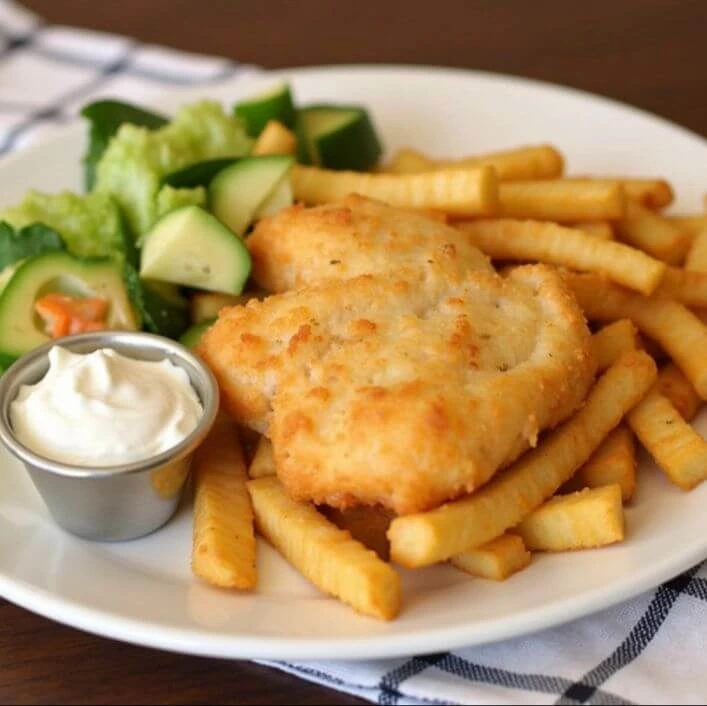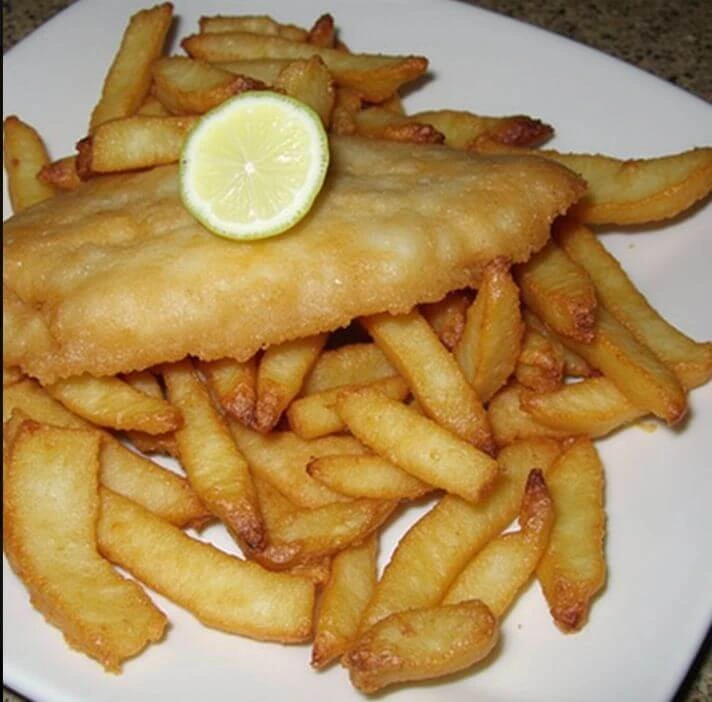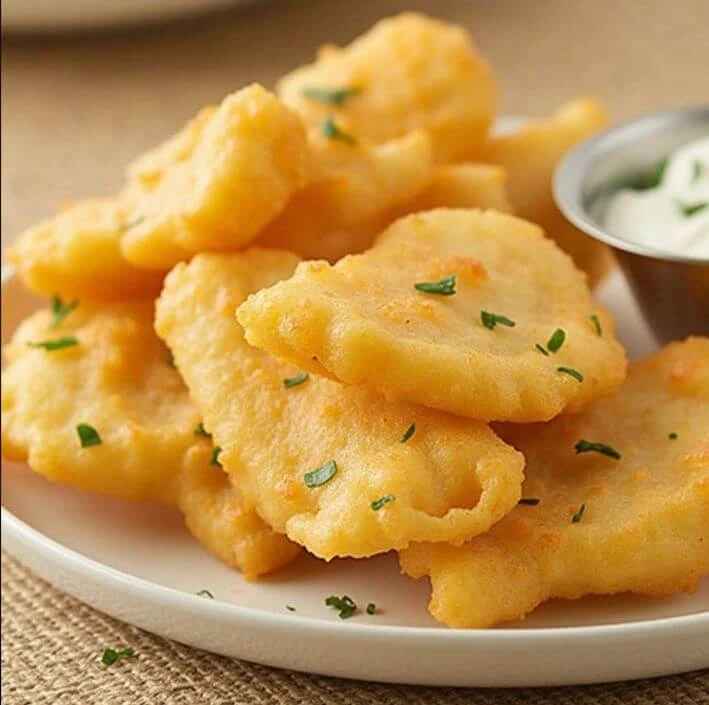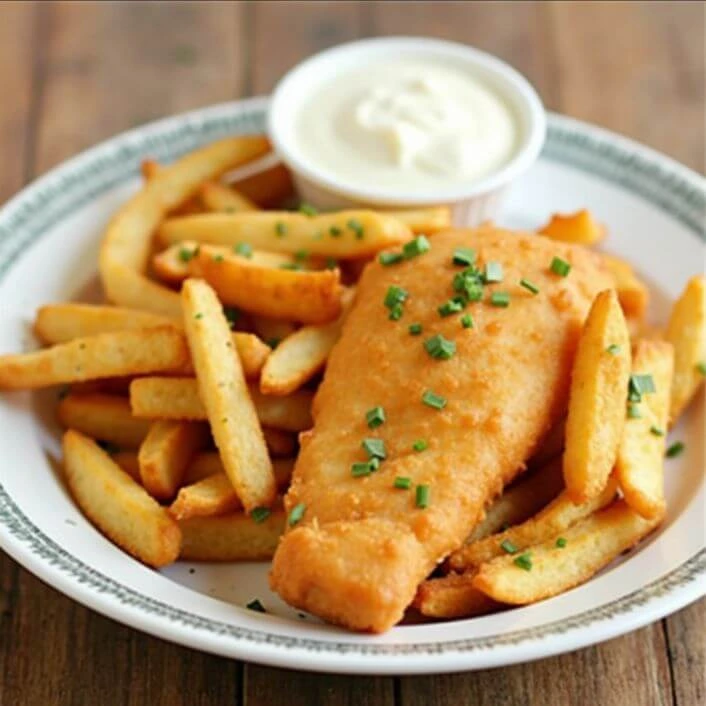Fish n Chips Recipe: What Makes This the Ultimate Classic
Fish n Chips Recipe is a dish that has stood the test of time, becoming a true symbol of British culinary heritage. With its crispy, golden fish fillets paired with perfectly fried, chunky fries, this meal has been cherished by people around the world for over a century. But what makes fish and chips so enduringly popular? Whether enjoyed at a local chippy (fish and chip shop) or made at home, this classic dish has a unique charm that speaks to both nostalgia and comfort.
In the UK, fish and chips are much more than just food – they’re a part of the culture. For many, it’s a traditional takeaway meal on a Friday night, a treat after a long day, or a way to celebrate special occasions. The simplicity of the dish, paired with its satisfying flavors, makes it universally loved. What’s more, it holds a place of pride in British history, often referred to as “The Nation’s Favorite.”
But there’s more to this dish than just its popularity. The combination of lightly battered, flaky fish, crispy fries, and the perfect condiments is a delicate balance of flavors and textures that, when done right, creates the ultimate comfort food experience. So, how can you recreate this British classic at home, and what makes a truly perfect fish and chips dish?
In this post, we’ll dive into the essentials of preparing the best Fish n Chips Recipe, from selecting the freshest fish like cod or haddock to achieving that signature crispy batter and pairing it with golden fries. We’ll also explore the perfect toppings and sides to complete this timeless dish. Let’s get cooking and discover why fish and chips are considered the ultimate comfort food!
Table of Contents
The Rich History of Fish n Chips: A British Culinary Tradition
Fish n Chips Recipe, a quintessential British dish, has roots dating back to the 19th century, when it first became a beloved comfort food in the UK. It was during the Industrial Revolution that this iconic combination of fried fish and crispy fries became a staple meal. The dish was originally introduced by Jewish immigrants from Portugal and Spain, who brought the tradition of frying fish to Britain. At the same time, the practice of frying potatoes, known as “chips,” was popular across Europe, and the two eventually came together to create the perfect pairing.
How the First Fish and Chip Shops Came to Be: The Rise of the Chippy
The first-ever fish and chip shop, or “chippy,” opened in London in 1860, quickly followed by other locations in northern England. This marked the birth of the fish and chips shop as a beloved British institution. These shops provided a quick, affordable meal for the working-class population, especially factory workers who needed a hearty lunch or dinner to fuel their long hours.
The Role of Fish n Chips During Wartime Britain: A Protected Meal
During World War II, Fish n Chips Recipe gained even more importance, becoming one of the few dishes unaffected by rationing. As a result, it was considered a “protected meal,” ensuring that fish and chips remained available to both soldiers and civilians. The dish became a symbol of national resilience, often enjoyed in times of hardship and even served at celebrations marking the end of the war.
Fish n Chips Today: The Ultimate British Comfort Food
Even in modern times, Fish n Chips Recipe remain a beloved classic in the UK. Whether you’re enjoying a meal at a traditional chippy, grabbing a takeaway, or making it at home, this dish continues to be a symbol of British culture. From its crispy fish fillets to the perfectly golden fries, fish and chips are an enduring favorite for people of all ages.
Choosing the Right Fish: Cod vs. Haddock
When making fish and chips, the type of fish you choose is key to the flavor and texture. Cod and haddock are the top two choices. Each brings something different to the dish. Let’s look at both options to help you decide which one works best for you.
Cod: The Traditional Favorite
Cod is the most popular fish choice for fish and chips. It has a mild, slightly sweet flavor. Its flesh is tender and flakes easily, making it ideal for frying. When battered and deep-fried, cod remains juicy on the inside. The batter crisps up beautifully on the outside.
Cod has a neutral taste, which makes it easy to pair with a variety of seasonings. Its moist texture helps it stay tender while frying. It’s also easy to find, affordable, and sustainable, making it a popular choice for both home cooks and restaurants.
Haddock: A Flavorful Alternative
Haddock is a great alternative to cod. It has a stronger, more savory flavor, with a slight sweetness. The texture is finer, with smaller flakes. Haddock tends to be firmer than cod, making it a great option for those who prefer a meatier bite.
Haddock is often favored in parts of Scotland. It retains its texture when fried and boasts a rich, bold flavor.If you like a more intense fish taste, haddock is the way to go.
Which One Should You Choose?
Choosing between cod and haddock depends on your personal taste. Cod is mild, light, and tender. Haddock offers a stronger, more flavorful bite with a firmer texture. Here’s a simple guide:
- Cod is ideal for a traditional, light fish and chips experience.
- Haddock has a richer taste and firmer texture for a heartier meal.
Both are excellent choices, so feel free to experiment. You might even try both for a unique fish and chips combination!
How to Make the Perfect Crispy Fish Batter

The batter is one of the most crucial elements in making perfect fish and chips. A light, crispy batter not only enhances the texture of the fish but also adds that signature crunch when you take your first bite. Getting the right batter consistency and cooking technique is key to achieving the ideal fish fry. Here’s a step-by-step guide to help you create the perfect crispy batter for your fish.
The Basic Ingredients for a Crispy Batter
A simple fish batter typically requires just a few key ingredients: flour, baking powder, salt, cold water or beer, and sometimes cornstarch. Here’s what each ingredient does:
- Flour: All-purpose flour is commonly used as the base for the batter. It helps create the structure and crispiness.
- Baking Powder: This is essential for giving the batter a light, airy texture. It helps the batter puff up and become crispy when fried.
- Salt: Enhances the batter’s flavor, complementing the taste of the fish.
- Cold Water or Beer: Cold liquids are essential for making the batter crisp. Beer is often used because it adds a slight malty flavor and carbonation, which makes the batter even lighter and crispier.
- Cornstarch: Some recipes add a small amount of cornstarch to give the batter an extra crispy texture.
How to Mix the Batter
The key to a crispy batter is to keep the ingredients cold and avoid overmixing. Here’s how to make the batter:
- Combine the dry ingredients: In a large bowl, mix together the flour, baking powder, salt, and cornstarch (if using).
- Add the cold liquid: Slowly pour in the cold beer or water, mixing gently as you go. It’s important not to overmix the batter, as this can make it dense. The batter should be lumpy – this is a good thing! The lumps help create an uneven texture, which results in more crunch once fried.
- Check the consistency: The batter should be thick enough to coat the back of a spoon but thin enough to drip off easily. If the batter is too thick, add a bit more cold liquid to loosen it up. If the batter is too loose, stir in a bit more flour to thicken it.
The Perfect Frying Technique
Now that you have the perfect batter, the next step is frying the fish. Here are some tips to ensure the batter stays crispy:
- Preheat your oil: The oil should be hot enough for frying – ideally, around 350°F (175°C). If the oil is too cold, the batter will soak up too much oil and become greasy instead of crispy.If the oil is too hot, the batter may burn before the fish is fully cooked.
- Dip the fish into the batter: Coat the fish fillets in the batter just before frying. Make sure they are evenly covered with a thick layer of batter.
- Fry in small batches: Frying the fish in small batches prevents the oil temperature from dropping too much, which helps the batter stay crispy. Overcrowding the pan can lead to soggy fish and uneven cooking.
- Flip the fish gently: Use tongs or a slotted spoon to turn it halfway through cooking. This ensures that the batter cooks evenly on both sides. Fry the fish until golden brown and crispy, which should take about 4-6 minutes, depending on the thickness of the fillet.
Additional Tips for Extra Crispiness
- Double coat the fish: For an extra crispy crust, you can dip the fish in the batter, then coat it in a light layer of flour or breadcrumbs before frying.
- Chill the batter: If possible, refrigerate the batter for 15-20 minutes before using. This helps it firm up and adhere better to the fish.
- Drain excess oil: After frying, place the fish on a paper towel-lined plate to drain any excess oil. This keeps the batter crisp and prevents it from becoming soggy.
Preparing the Ultimate Chunky Fries for Your Fish n Chips

While the crispy fish is often the star of the show, the fries, or chips as they’re known in the UK, are just as essential to the perfect fish and chips experience. The ideal fries should be thick, crispy on the outside, and soft and fluffy on the inside. Achieving this texture requires a bit of technique, but it’s well worth the effort. Here’s how you can prepare the ultimate chunky fries to complement your crispy fish.
Choosing the Right Potatoes
The key to great fries starts with the right potato. For the perfect chunky fries, you’ll want to use starchy potatoes, such as Russet potatoes or Maris Piper (a British variety). These potatoes have a high starch content, which helps them become fluffy on the inside while maintaining a crisp exterior.
It’s best to avoid waxy potatoes (like red potatoes) because they have less starch and can result in fries that are too waxy or soggy.
How to Cut the Perfect Chunky Fries
When it comes to chunky fries, size matters. The key is to cut your potatoes into thick, uniform pieces to ensure even cooking. Here’s how to cut them properly:
- Peel or leave the skin on: It’s a matter of personal preference. Keeping the skin adds texture and enhances the flavor. If you prefer skinless fries, simply peel the potatoes first.
- Cut the potatoes: To create the classic chunky fries, slice the potatoes into thick wedges or baton-style cuts. Aim for each piece to be about 1 to 1.5 inches wide. For even cooking, make sure the fries are cut to a uniform size.
- Soak the fries: After cutting the potatoes, place them in cold water for at least 30 minutes, or overnight if possible. This step removes excess starch, which can cause the fries to become too sticky and prevent them from getting crispy. Soaking helps the fries achieve that perfect fluffy interior once fried.
The Double Frying Technique for Perfect Fries
The secret to getting that golden, crispy texture is the double frying technique. Here’s how you do it:
- First fry (blanching): Heat your oil to around 325°F (165°C). Fry the potatoes in batches for about 3-4 minutes, just until they start to soften but haven’t yet turned golden. This initial fry is to cook the potatoes through without crisping them too much. Remove the fries from the oil and let them rest on paper towels to drain.
- For the second fry (crisping): raise the oil temperature to 375°F (190°C).Fry the potatoes again, in batches, for about 3-4 minutes or until they turn a beautiful golden brown and crisp up. This second fry ensures that the fries have a crispy exterior and a soft, fluffy interior.
Seasoning the Fries
While fish and chips are traditionally served with just a sprinkle of salt, you can get creative with your seasoning. After the fries have been fried and drained, toss them in a little extra sea salt for that classic flavor. If you want to elevate the taste, you can add other seasonings such as:
- White vinegar: A classic British touch, adding just a few dashes of vinegar can give your fries a tangy edge.
- Herbs: A light sprinkle of parsley or thyme can add a refreshing herbal note to your fries.
- Pepper: Freshly ground black pepper can enhance the flavor, adding a subtle kick to balance the richness of the fried batter.
Keeping Your Fries Crispy
If you’re not serving your fries immediately, you can keep them crispy by placing them on a wire rack, which allows air circulation and prevents them from becoming soggy. If you must hold them for a while, keep them in a warm oven (around 200°F or 90°C) until ready to serve.
Serving and Pairing: The Best Toppings and Sides for Fish n Chips
Once you’ve perfected your crispy fish and chunky fries, it’s time to think about how to serve and elevate the dish with some classic toppings and sides. Fish n Chips Recipe is often served as a simple, satisfying meal on its own, but adding the right accompaniments can take it to the next level. Whether you want to stick to tradition or add a bit of creativity, here are some great toppings and side dishes to pair with your fish and chips.
Classic Toppings and Sauces for Fish n Chips
Fish and chips can be enjoyed in its simplest form, but the right sauce or topping can enhance the flavors and bring a new dimension to the dish. Here are some must-try options:
Malt Vinegar
This is a quintessential British topping for fish and chips. The tangy, slightly acidic flavor of malt vinegar balances out the rich and crispy fried fish and fries. Drizzle it generously over the fish and chips for an authentic touch.
Tartar Sauce
A creamy, tangy tartar sauce is another classic condiment that pairs beautifully with fish. Made from mayonnaise, pickles, capers, and lemon juice, it adds a smooth, zesty contrast to the crispiness of the batter. You can also try variations with fresh herbs like dill or parsley for an extra burst of flavor.
Ketchup
Though less traditional in the UK, ketchup is still a popular condiment for chips (fries) in some places. The sweet and tangy taste of ketchup works well with the fried potatoes, providing a contrast to the richness of the fish and batter.
Lemon Wedges

A squeeze of fresh lemon over the fish brings a burst of citrus that complements the mild, flaky fish. The acidity of lemon cuts through the richness of the fried food and adds a refreshing zing to every bite.
Curry Sauce
In some parts of the UK, especially in the north, curry sauce is a beloved topping for fish and chips.The warm, spiced sauce adds a bold, flavorful punch to the traditional dish. It’s often served as a side, so diners can dip their chips or pour it over the fish.
Mushy Peas
This is another traditional side dish for fish and chips, especially in the UK. Mushy peas are made from marrowfat peas that are cooked and mashed to a smooth, slightly textured consistency. Seasoned with a bit of butter and salt, they offer a simple, earthy contrast to the crispy fish and fries.
Side Dishes to Complement Fish n Chips
While the fish and fries are the stars of the dish, a few well-chosen side dishes can complement the meal and add variety. Here are some great options:
Coleslaw
A creamy, tangy coleslaw is a fantastic side to serve with fish and chips. The crispness of shredded cabbage and carrots, paired with a tangy dressing, brings a refreshing touch to the dish.The coolness of coleslaw balances the hot, crispy fish and fries.
Pickled Onions
Pickled onions are a classic accompaniment to fish and chips in many fish and chip shops. Their tangy and slightly sweet flavor cuts through the richness of the fried food, adding a bit of bite and texture to the meal.
Grilled Tomatoes
If you’re looking for a lighter side dish, grilled tomatoes offer a juicy, flavorful option. Their natural sweetness and acidity complement the savory flavors of the fish and chips, providing a nice contrast.
Green Salad
A simple, fresh green salad with a light vinaigrette is an excellent way to balance out the heaviness of the fried fish and chips. The crispness of the greens and the tanginess of the dressing refresh the palate and add a light, healthy element to the meal.
Sweet Potato Fries
For a twist on the classic fries, try serving sweet potato fries alongside your fish. Their natural sweetness pairs well with the savory fish and batter, and the texture of sweet potato fries is slightly crisp on the outside, with a soft, fluffy inside.
Drinks to Pair with Fish n Chips
Choosing the right drink to pair with your fish and chips can enhance the meal even more. Here are a few popular options:
Beer
A classic pairing for fish and chips, a cold beer complements the crispy batter and helps to cleanse the palate. Traditional British ales or lagers are great choices, but a crisp, refreshing pilsner or IPA works well too. The carbonation and slight bitterness of beer balance the richness of the fried food.
Cider
If you prefer something lighter and more refreshing, a chilled glass of hard cider is another popular drink choice. The slightly fruity, tangy flavor of cider pairs beautifully with both the fish and the fries, adding a touch of sweetness to balance the savory flavors.
Sparkling Water
For those who prefer non-alcoholic options, sparkling water is a great choice. Its effervescence cleanses the palate between bites and refreshes the taste buds, making it the perfect companion to the crispy fish and chips.
Lemonade
A glass of freshly squeezed lemonade is a fantastic drink to pair with your fish and chips. The tartness of the lemonade contrasts nicely with the richness of the fish, and its citrusy flavor complements the fresh lemon squeezed over the fish.
Conclusion: Why Fish n Chips is the Ultimate Comfort Food
Fish n Chips Recipe is a beloved classic, cherished by many for its perfect balance of crispy and tender textures, savory flavors, and comforting qualities. From its humble beginnings as a staple of British street food to its status as an iconic dish enjoyed worldwide, fish and chips has earned its place as a timeless favorite.
The Perfect Combination of Crispy and Tender
The key to a great fish and chips meal lies in the delicate balance between the crispy, golden batter and the flaky, tender fish inside. Whether you choose traditional cod or haddock, the fish provides a subtle, mild flavor that complements the rich batter perfectly. Likewise, the fries (or chips) should be thick, soft on the inside, and crispy on the outside. The technique of double frying ensures that every bite delivers that satisfying crunch and soft, potato interior that makes fish and chips so irresistible.
A Meal for Any Occasion
One reason fish and chips continue to be a favorite is their versatility. It’s a meal that can be enjoyed at any time—whether you’re sitting in a cozy pub, enjoying a casual family dinner, or indulging in a takeout treat. Its simplicity, combined with the variety of toppings and sides that can accompany it, makes fish and chips suitable for any occasion. From malt vinegar and tartar sauce to mushy peas and pickled onions, the possibilities for customization are endless, allowing you to tailor the meal to your taste.
The Comfort of Tradition
While modern variations and creative twists on the classic dish continue to emerge, there’s something inherently comforting about the traditional Fish n Chips Recipe served in its classic form. It evokes a sense of nostalgia, especially for those who associate it with trips to the seaside or local fish and chip shops. The warm, crispy fish and chips paired with the right sauce and sides deliver a sense of familiarity that’s hard to beat. It’s a meal that brings people together, whether shared at a family gathering, with friends, or enjoyed solo during a cozy evening.
Why You Should Try It at Home
Making fish and chips at home allows you to experience the dish at its best—crispy, fresh, and customized to your preferences. By following the tips outlined in this post, you can achieve the perfect batter, the crispiest fries, and a combination of toppings and sides that will rival your favorite takeout spot. Not only does it provide a fun cooking experience, but it also allows you to savor the dish at its freshest, giving you the satisfaction of creating something truly special.
In the end, Fish n Chips Recipe isn’t just a meal—it’s a culinary experience, one that has stood the test of time and remains as popular today as ever. Whether you’re enjoying it in a traditional way or experimenting with new flavors, fish and chips is sure to deliver that comforting, satisfying feeling every time. So, next time you crave something hearty and delicious, why not give the ultimate classic a try? You won’t be disappointed!


I was drawn into your words immediately, not just by the ideas, but by the warmth they radiate.